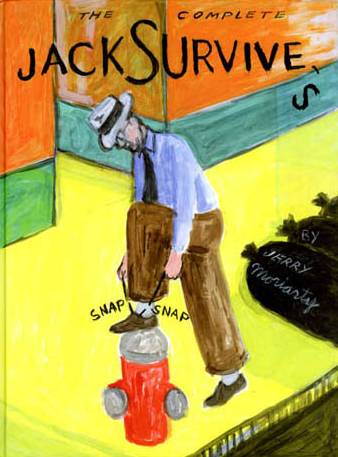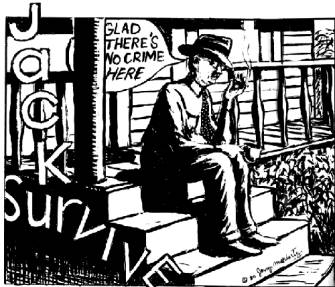 Home > CR Reviews
Home > CR Reviews The Complete Jack Survives
posted September 1, 2009
The Complete Jack Survives
posted September 1, 2009

 Creator:
Creator: Jerry Moriarty
Publishing Information: Buenaventura Press, hardcover, 80 pages, July 2009, $34.95
Ordering Numbers: 9780980003932 (ISBN13)
It's one thing to get Chris Ware to write an introduction to your book, but it's quite another thing to get him to declare your book potentially the most import comics reprint book of all time, as takes place about a dozen pages into Buenaventura Press' stylish
The Complete Jack Survives. Ware is speaking of both the value of the work contained within this book's cover and the nosebleed-level high prices engendered by any remaining copies of Moriarty's 1980s RAW Books solo effort whenever they shimmer to the collective antiquarian surface, but mostly the work, which he describes in flattering, precise prose for twice as long as one might expect a cartoonist of his stature to pen. I agree with Chris Ware, and hope that as many of you as possible consider owning this book. I can't speak for its rank in the pantheon but
The Complete Jack Survives is a rare, forceful, whole statement about comics, what they offer and accomplish. I've been reading it over and over for two weeks straight, and I imagine I'll still be picking it up next from its place next to a living room chair by the time Halloween rolls around.
My understanding as supported by Moriarty's own statements is that the character of Jack is a version of the artist's better self as realized through the visual representation of his father in the year of his passing. They began in part when Moriarty reached that moment when for the first time one remembers their father at the exact time of his life which you now inhabit. The tableau depicted through a variety of media up to and including full-on paintings -- there are studies for some of those more completely realized art that are equally as gorgeous -- frequently show Jack in some way beset by the indignities of everyday life. Less noticeable but equally important is how authoritatively Moriarty places his characters in a series of very specific environments: hallways and attics and sitting rooms and sidewalks. It's not difficult to see those scenes as commentary on the 20th century patriarchal stereotype, a lengthy visual essay on those men that only rarely seemed to take their hats off. But the rest of us are in there, too. We all have those moments, we all settle into a place, and we all build lives out of offhand moments and stultifying routine.
When I read these comics in RAW, I read them with a kind of leftover momentum from taking in other comics between the covers. I would bounce through them, in a way that turned what I was seeing into a kind of deadpan joke. Those elements are still present in
The Complete Jack Survives but in this context I tend to plow through each individual strip more slowly, lingering on after images or lost balloons, appreciate the graspable solidity that Moriarty brings to objects and backgrounds. He's an interesting cartoonist in addition to being a painter that works with cartoon elements and imagery. For example, there's a nice trick he does with garbled letters and their placement within balloons that adds more variety to the effect of misunderstood speech than other cartoonists care to achieve. Mostly, though, it's the weight of the visuals that keeps this book near to my lap, the reassurance that can be gleaned from a mostly unremarkable life.



